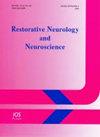腕肘管综合征患者压迫程度与手灵巧度、睡眠、生活质量、神经性疼痛和焦虑抑郁的关系
IF 1.6
4区 医学
Q4 NEUROSCIENCES
引用次数: 0
摘要
目的:腕、肘管综合征是一种常见的压迫性神经病变。先前的一些研究表明,腕管综合征和肘管综合征(在较小程度上)会损害睡眠和生活质量[2-4]。但是比较这两种症状的研究很少。然而,在文献中没有发现通过神经电图(ENMG)来评估两种综合征的手灵活性、睡眠质量、生活质量和神经性疼痛与压迫程度的关系的研究。因此,本研究旨在探讨临床和电生理诊断为腕管综合征和肘管综合征患者不同压迫程度的手灵巧度、睡眠质量、生活质量、神经性疼痛和焦虑抑郁症状之间的关系。材料和方法:本研究纳入申请ENMG实验室的患者,年龄在18岁及以上,经临床和电生理诊断为腕管综合征和肘管综合征。同意参与研究的患者的社会人口学和临床数据被记录下来。腕管综合征采用美国电诊断医学协会基于电生理数据的分类[12]分为轻度、中度和重度,肘管综合征采用Zeidman和Pandey基于美国电诊断医学协会实践指南[13]创建的电诊断分级系统进行分类。采用匹兹堡睡眠质量指数[14,15]和Epworth嗜睡量表[16,17]评估患者的睡眠质量,采用EuroQuol-5D生活质量量表[18,19]评估患者的生活质量,采用4项神经性疼痛量表[20,21]评估患者的神经性疼痛,采用医院焦虑抑郁量表[22,23]评估患者的焦虑和抑郁水平,采用9孔Peg测试[24]评估患者的手灵活性。填写表格后,对腕管综合征患者与肘管综合征患者的数据进行统计比较。此外,在将患者分为轻度、中度和重度后,比较两组患者在每组内的发现,并调查他们之间的关系。结果:睡眠障碍、神经性疼痛、抑郁和焦虑障碍在CTS患者中比在CuTS患者中更为普遍,并且这些障碍的严重程度随着疾病严重程度的增加而增加。CTS患者在精细运动技能方面也落后于CuTS患者。结论:应注意,这些参数均对患者的生活质量产生负面影响。早期物理治疗和康复对患者的治疗是有益的,可以提高他们的生活质量。本文章由计算机程序翻译,如有差异,请以英文原文为准。
Relationship Between Compression Severity and Hand Dexterity, Sleep, Quality of Life, Neuropathic Pain, and Anxiety-Depression in Patients with Carpal and Cubital Tunnel Syndrome
Objective: Carpal and cubital tunnel syndromes are common entrapment neuropathies [1]. Some previous studies showed that carpal tunnel syndrome and, to a lesser extent, cubital tunnel syndrome can impair sleep and quality of life [2-4]. But there are only few studies comparing these two syndromes [5]. However, no study, which evaluates hand dexterity, sleep quality, quality of life, and neuropathic pain in relation to the severity of compression determined by Electroneurography (ENMG) in both syndromes, could be found in the literature. Thus, it was aimed in the present study to investigate the relationship between hand dexterity, sleep quality, quality of life, neuropathic pain, and anxiety-depression symptoms with different levels of compression severity in patients clinically and electro-physiologically diagnosed with carpal tunnel syndrome and cubital tunnel syndrome. Materials and methods: This study involved patients, who applied to the ENMG laboratory and were18 years or older and clinically and electro-physiologically diagnosed with carpal tunnel syndrome and cubital tunnel syndrome. The sociodemographic and clinical data of the patients who agreed to participate in the study were recorded. Carpal tunnel syndrome was classified as mild, moderate, and severe by using the American Association of Electrodiagnostic Medicine Classification [12] based on electrophysiological data, whereas the classification of cubital tunnel syndrome was performed by using the electrodiagnostic grading system created by Zeidman and Pandey based on the American Association of Electrodiagnostic Medicine practice guidelines [13]. The Pittsburgh Sleep Quality Index [14,15] and Epworth Sleepiness Scale [16,17] were used in evaluating the sleep quality of the patients, the EuroQuol-5D Quality of Life Scale [18,19] for quality of life, the 4-item neuropathic pain scale [20,21] for neuropathic pain, the Hospital Anxiety and Depression Scale [22,23] for anxiety and depression levels, and the 9-Hole Peg Test [24] for hand dexterity. After the forms were filled in, the data of the patients having carpal tunnel syndrome and those of patients having cubital tunnel syndrome were compared statistically. Moreover, after staging them as mild, moderate, and severe, the findings of patients in both groups were compared within each group, and their relationships were investigated. Results: Sleep disorders, neuropathic pain, depression, and anxiety disorders were observed to be much more prevalent among patients with CTS when compared to the patients with CuTS and the severity of these disorders increases together with an increase in the severity of the disease. It was also determined that CTS patients lag behind CuTS patients in fine motor skills. Conclusion: It should be noted that all of these parameters negatively affect the quality of life of patients. Early physiotherapy and rehabilitation can be beneficial in the treatment of patients and can contribute to their quality of life.
求助全文
通过发布文献求助,成功后即可免费获取论文全文。
去求助
来源期刊
CiteScore
5.40
自引率
3.60%
发文量
22
审稿时长
>12 weeks
期刊介绍:
This interdisciplinary journal publishes papers relating to the plasticity and response of the nervous system to accidental or experimental injuries and their interventions, transplantation, neurodegenerative disorders and experimental strategies to improve regeneration or functional recovery and rehabilitation. Experimental and clinical research papers adopting fresh conceptual approaches are encouraged. The overriding criteria for publication are novelty, significant experimental or clinical relevance and interest to a multidisciplinary audience. Experiments on un-anesthetized animals should conform with the standards for the use of laboratory animals as established by the Institute of Laboratory Animal Resources, US National Academy of Sciences. Experiments in which paralytic agents are used must be justified. Patient identity should be concealed. All manuscripts are sent out for blind peer review to editorial board members or outside reviewers. Restorative Neurology and Neuroscience is a member of Neuroscience Peer Review Consortium.

 求助内容:
求助内容: 应助结果提醒方式:
应助结果提醒方式:


